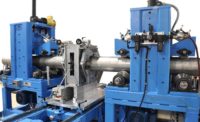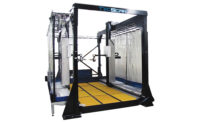NDT Compliance: The Proper Test for High Quality Lamps
Standards are constantly getting upgraded to make NDT safe and reliable for inspectors and the public.

NDT testing with a UV-A/white light LED NDT inspection lamp.
Nondestructive testing (NDT) is used in engineering industries to test equipment, components, and materials without causing any damage. With a reliance on quality assurance and rating systems for tools to be used for the correct tasks, adhering to industrial safety norms is a large factor behind the NDT market.
Product reliability must be tested to meet industry codes and standards before they are released to consumers. These codes and standards showcase what goes into product reliability testing, especially if those companies create products for different industries and different countries.
The advent of the industrial revolution created a greater need for NDT. Now, it is used in nearly every manufacturing and engineering process to inspect parts, welds, and structures. Standards are constantly getting upgraded to make NDT safe and reliable for inspectors and the public.
Allowing for early detection of surface and subsurface defects in products, NDT is a useful tool for quality control in the manufacturing process. For performing NDT inspection, different types of techniques can be used. Depending on the application, it is important to ensure that the components in use continue to maintain their integrity, ensuring usefulness and safety.

NDT lamps can also come as a stationary overhead flood lamp.
Many governmental agencies and regional bodies (such as the American Society of Mechanical Engineers and the International Organization for Standardization) are instituted across the world to take stringent measures for assuring safety and overseeing testing. ASTM International (formerly the American Society for Testing Materials) is an important organization that serves as an open forum for the development of international standards in NDT testing. The organization was originally formed by a coalition of scientists and engineers in 1898 to address the frequent rail breaks affecting the fast-growing railroad industry. The group developed a standard for the steel used to fabricate rails. ASTM standard E3022 ensures the reliability and efficiency of UV-A lamps used in fluorescent inspection and NDT testing. The most recent revision, as of September 2018, is ASTM E3022-18.
ASTM E3022 is the performance requirement for ultraviolet A (UV-A), light emitting diode (LED) lamps used in liquid penetrant and magnetic particle testing. This standard is intended primarily for UV lamp manufacturers, and includes reporting and performance requirements for UV-A LED lamps. It details procedures and data collection used by UV-A lamp manufacturers to certify LED lamps for NDT use. It is not intended to be referenced by end users. For a UV-A light source lamp to be certified as E3022-compliant, two levels of certification are performed. This includes model-type testing to qualify lamp designs, and individual-unit testing to confirm every single lamp that crosses the production line is compliant.

Flaws on items such as screws can be found clearly with NDT lamps that have undergone compliance testing.
Another compliance standard that manufacturers of NDT lamps follow is Rolls-Royce, RRES 90061. This is specified for LED UV-A lamps, including test requirements for the product design and each individual lamp. One major area of importance to note in regards to ASTM and RRES is that all lamps which are RRES-compliant meet ASTM test values by default, but not all ASTM-compliant lamps meet RRES standards. When finding a flaw using compliant lamps, it is important to use a product that was tested at the standard required to find said flaw.
Reading all of this information, one might ask “Why does it matter how many nanometers a lamp needs to find flaws?” Why does compliance matter? Here’s an example of what happens when you have a lamp that’s marketed as compliant, but is not. You have a lamp, and you’re looking for a flaw in a part of an airplane. Your lamp is advertised to peak at 365 nanometers, but it peaks at 385. It will not correctly find the flaw you would need to ensure the stability and safety of an airplane. One would think everything is fine, and the airplane can move along its charted flight. Your passengers and airline staff are on board, and the flight takes off. While you are airborne, the flaw in the airplane increases in size, and there is a malfunction. The end result is worse than the “gremlin on the wing” scenario we have seen on a famous television series. This is a real-life scenario that could have been avoided if the manufacturer had been honest on the compliance of their product to find flaws in an airplane.
Public trust, product safety, and satisfying requirements (specific design requirements, physical proportions, etc.) are important factors in regard to compliance testing. A manufacturer who works as an importer is responsible for ensuring that all products placed on the market are safe, assessing all usage and safety aspects when developing new products.
ASTM E3022 and RRES 90061 are intended to be referenced only by the manufacturer to certify the performance of specific lamp models (housing, filter, diodes, electronic circuit design, optical elements, cooling system, and power supply combination) and also includes limited acceptance tests for individual lamps delivered to the user. These test procedures are not intended to be utilized by the end user.
The performance of a compliant NDT lamp is certified with rigorous manufacturer testing and recorded on a fully serialized certificate. This document shows that the lamp has met all of the following requirements before it is shipped. Tests for compliance include running an intensity profile (which involves the recording of the peak intensity of a lamp at microwatts per square centimeter from a distance, and the recording of the area of coverage) and a durability report (which involves a chemical resistance test and a drop test). Chemicals during testing can include kerosene, and drop tests can have a height up to one meter. Once all testing is completed (including lamp acceptance test requirements, emission spectrum measurements, and filter transmittance), a signed certificate is required for every lamp manufactured. Again, think of the airplane scenario discussed earlier. If you state your lamp is compliant, but does not shine at the peak as advertised, it will not find the flaw that is causing issue to your car/plane/structure. This could lead to bigger problems down the road.
End users should never be fooled by companies claiming compliance. ASTM and RRES standards are strict, yet essential to the NDT industry. Several lamps are falsely marketed as compliant, and this undermines the importance of NDT standards. Some ways to identify a non-compliant lamp include:

UV lamps can find flaws that are not easily seen.
- Wavelength Test: Shine the lamp at a spectroradiometer to determine the wavelength. To meet ASTM E3022 and RRES 90061 standards, the lamp must have a peak wavelength of 365 (+/-5) nanometers.
- Current Ripple Test: A lamp is plugged into an oscilloscope to measure the current ripple. By ASTM E3022 standards, the ripple may not exceed 5%. For RRES 90061 it may not exceed 6%.
- Intensity Test: Shine the lamp at a radiometer from 15” away and observe the intensity. Per RRES 90061, the intensity cannot be greater than 5,000 microwatts per square centimeter.
- Output Stability Test: Just as with the intensity test, the lamp is shined at a radiometer from 15” away, and the intensity is observed. To meet the RRES 90061 standard, manufacturers are required to determine the stability time (Ts), which is the time from initial “switch on” to the point where output stability is achieved.
- Battery Decay Test: Battery life is measured a recorded in a graph.
- Housing Temperature Test: A thermometer measures the temperature of the lamp’s housing, and per ASTM 3022 it may not exceed 120°F under normal usage.
Prior to release to the public, the packaged product will state which exams were performed and passed. Products should state the standards and certifications they pass both on packages and in manuals. All ASTM-compliant lamps must be provided with a unique certificate of conformance (CoC) and all RRES-compliant lamps need a unique validation report (VR) to assure that the new lamp has been tested and reported to meet the requirements. If these documents are not included, then that lamp is not compliant. The importance of the documentation correlates with the lamp’s proper usage. The last thing any end user would need is for an inspector to run a test with a non-compliant lamp, find no flaw, and be told everything is in good shape. In actuality, the flaw will deteriorate more because a lamp did not function properly to find the flaw.
A product manufacturer must always provide their suppliers with compliant and ready-made label files. CoCs are used by auditors and customers to check for product compliance. If not, auditors will issue fines and may enforce a product recall without the full set of documents (regardless if your product is compliant). Product regulations tend to be administered by different government bodies.

Inspectors work diligently to inspect for flaws in designs, thanks to the help of compliant lamps.
The NDT market is competitive in nature. Increasing regulations make it necessary for organizations to perform regular inspections to check for equipment damage. Any time a compliant lamp undergoes a repair, it is necessary to generate a brand new CoC/VR. It is integral to a product’s reliability to operate at its stated peak for properly find flaws. Otherwise, the lamp has no value to the end user.
When a company promises that its product will do something but does not deliver on that promise, then it has engaged in false advertising, which is an illegal practice. If an NDT manufacturer falsely advertises a product as compliant, the issue of liability arises.
It is important to create and keep files comprised of design drawings, applied standards, photocopies of certificates and manuals, and risk assessments.
Looking for a reprint of this article?
From high-res PDFs to custom plaques, order your copy today!




